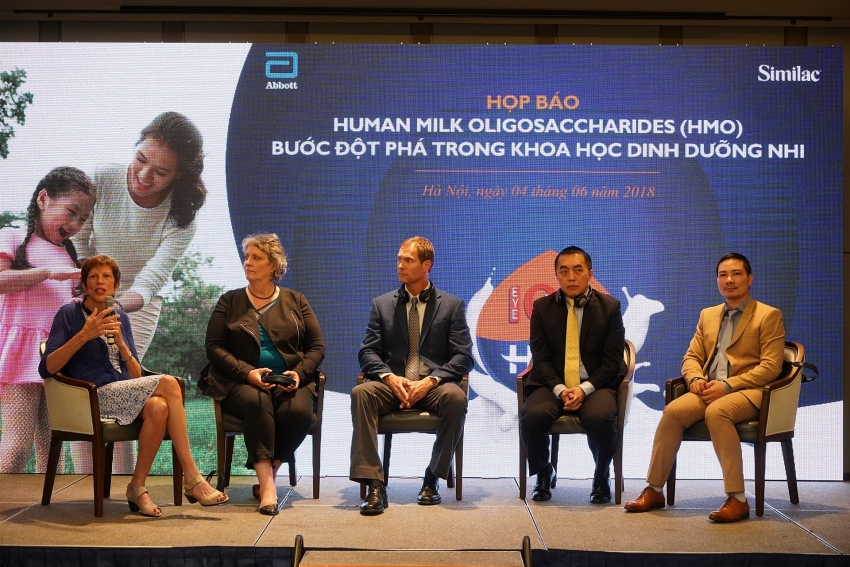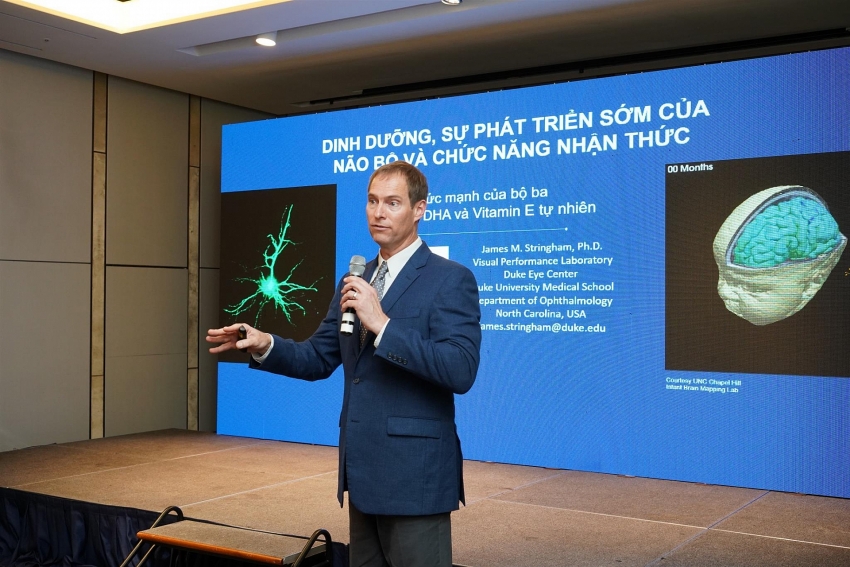Abbott launches flagship immune system strengthening infant formula
 |
| The press conference introducing HMO to Vietnam |
In the press conference where Abbott officially introduced Similac with HMO to Vietnam, VIR had the opportunity to have an in-depth discussion with Dr James Stringham from Duke University Medical School, Dr Ardythe L. Morrow (Professor of Pediatrics, Epidemiology, and Nutrition, Cincinnati Children Hospital), and Dr Barbara Marriage (Global Science Lead, Pediatric Specialty Nutrition, Abbott) on the critical window for brain and immunity development for babies, and the role of nutrition in that development.
 |
| James Stringham |
How does a baby’s brain develop after birth and what is the role of nutrition in that development?
James Stringham: Nutrition plays a very important role in the baby’s brain development. We have known for about 10 years now how crucial it is to nourish the brain in the first couple years of life. The brain is composed of 200 billion neurons when the child is born, and the key to developing a smart brain is to have those neurons talk to each other, to communicate. And nutrition makes that happen. These specific nutrients–Lutein, natural vitamin E, and DHA—seem to promote these connections.
 |
| Barbara Marriage |
Moms always want the best for their babies, but they might not have sufficient information. What are your recommendations on infant nutrition?
Barbara Marriage: The best nutrition for an infant is breast milk. It is the gold standard and we know that it is what mothers should feed their babies. However, sometimes mothers are unable to provide breast milk for their babies.
One of the gaps between breast milk and infant formula is the ingredients that help improve immunity. At Abbott we have found through intensive research and clinical study that the addition of HMO, specifically 2’-FL, nourishes the baby’s immune system. That would be the second best for the babies of the mothers who cannot breastfeed.
 |
| Ardythe L. Morrow |
It is important to provide nutrition to improve the baby’s immunity as soon as possible, isn't it?
Ardythe L. Morrow: The immune system is the body’s way of protecting itself. The world has lots of microbes, bacterium, viruses, and other disruptions to health.
When the health of a baby is disrupted, it is very hard to continue healthy development or even good brain development. In nutrition, start with breast feeding if it is possible. If it is not, then use a formula that has immune benefits, particularly HMO.
Could you share more about the HMO research process at Abbott? How long did it take to get important findings?
| After we discovered the benefits of HMO, we took years to learn how to replicate it and put this special ingredient into infant formula. |
Barbara Marriage: For years, scientists at Abbott have known there was a special ingredient in breast milk called HMO, but back then we did not really know what the function of this ingredient was. It took many years for us to learn its benefits to the infant immune system.
After we discovered the benefits of HMO, we took years to learn how to replicate HMO and how to add this special ingredient to infant formula. Even after that, we had to continue studying how they work in a cell model, then make sure that they are safe.
We did a lot of clinical studies to look at the content of human milk and the safety of the ingredient before we added it to the infant formula. Even then, we constantly monitored the infants to make sure that they tolerate the ingredient well and that it does not have any adverse impact. We also compared their data with a reference group of babies who were breastfed. That is why it really took a long time from finding the ingredient to being able to be put it into the infant formula.
With the launch of Similac Eye-Q Plus with HMO—the first infant formula fortified with immune nourishing human milk oligosaccharides HMO—Abbott has made a breakthrough in infant nutrition science and raised a new flagship in the Vietnamese milk formula market. Can you tell us the next direction of pediatric nutrition research at Abbott?
Barbara Marriage: We will continue researching HMO, because it has been such a huge area of interest. We will keep looking at the 2’FL-HMO we found to see whether it has other functions. We will continue our work, as we already know it has other functions like feeding beneficial bacteria, acting as a decoy or helping heal the gut, but we are looking if it does other things.
We also know there are over 100 different HMOs. We know quite a bit about the 2’-FL, the most abundant, but we are going to continue to look at the functions of some of the other HMOs. However, that research will take a long time as you see how long it took us to put 2’-FL in a formula. We continue because we know now how important HMOs are for babies.
What the stars mean:
★ Poor ★ ★ Promising ★★★ Good ★★★★ Very good ★★★★★ Exceptional
Related Contents
Latest News
More News
- Future of Vietnam's economy: opportunities and challenges (March 05, 2025 | 14:00)
- Pham Van Hoanh appointed new VIR's editor-in-chief (March 04, 2025 | 08:24)
- Steel industry navigating global challenges (March 03, 2025 | 15:34)
- State agencies offer solutions for economic growth (February 28, 2025 | 19:40)
- Petrolimex and ADB shake hands on energy transition (February 27, 2025 | 18:03)
- New Zealand's McCrae Hospitals and Orion Health expand Vietnam footprint (February 27, 2025 | 17:13)
- Education cooperation continues between New Zealand and Vietnam (February 27, 2025 | 16:38)
- Vietnam seeks UK expertise in financial centre development (February 27, 2025 | 16:24)
- Milcon Gulf Group expresses interest in international financial centre (February 27, 2025 | 10:50)
- Nghe An to open bidding to select investor for Quynh Lap LNG-fired power plant (February 25, 2025 | 19:54)




 Tag:
Tag:


















 Mobile Version
Mobile Version